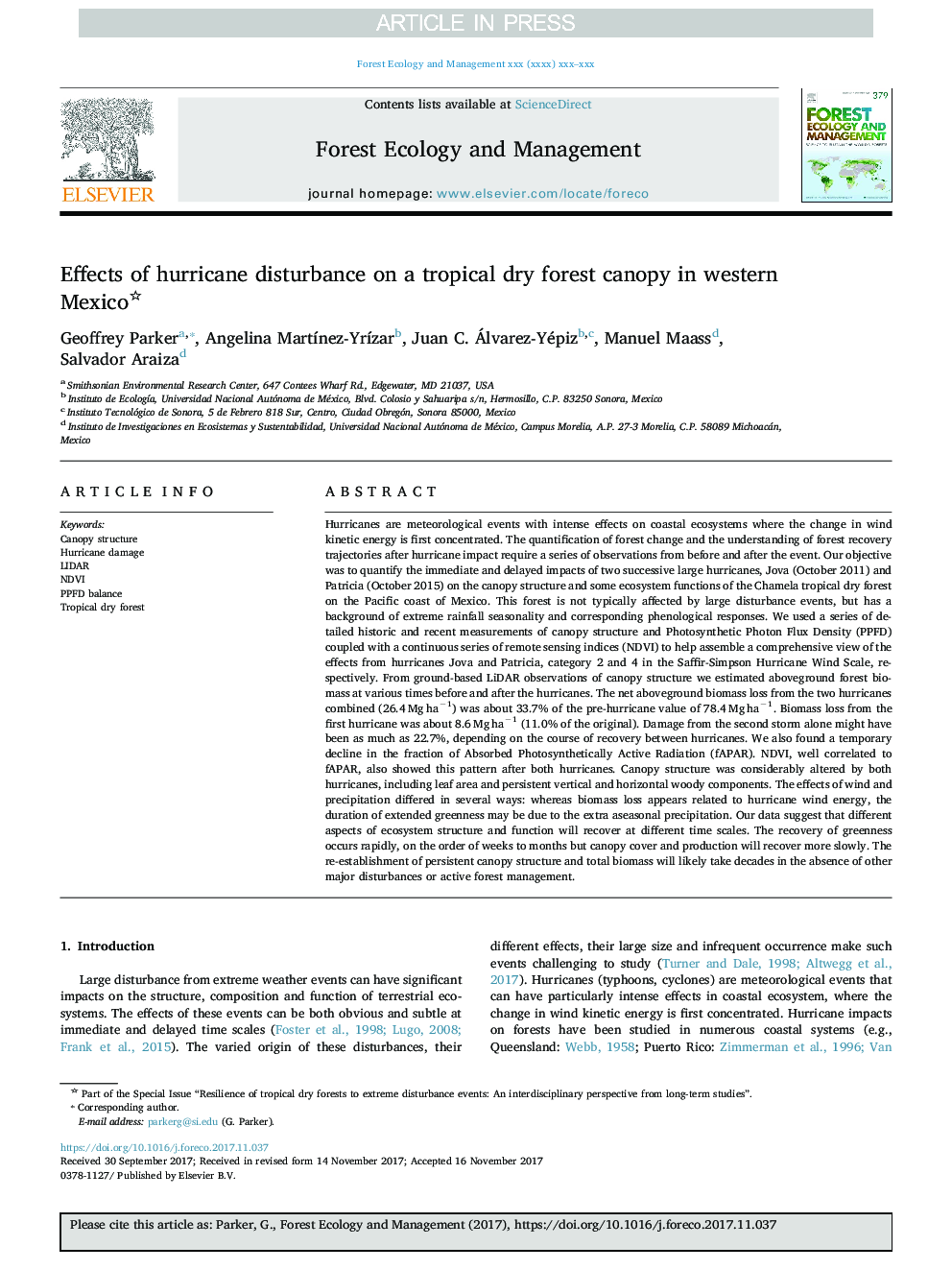| کد مقاله | کد نشریه | سال انتشار | مقاله انگلیسی | نسخه تمام متن |
|---|---|---|---|---|
| 6541541 | 1421334 | 2018 | 14 صفحه PDF | دانلود رایگان |
عنوان انگلیسی مقاله ISI
Effects of hurricane disturbance on a tropical dry forest canopy in western Mexico
ترجمه فارسی عنوان
اثرات اختلال طوفان در یک کاناپه خشک جنگل گرمسیری در غرب مکزیک
دانلود مقاله + سفارش ترجمه
دانلود مقاله ISI انگلیسی
رایگان برای ایرانیان
کلمات کلیدی
موضوعات مرتبط
علوم زیستی و بیوفناوری
علوم کشاورزی و بیولوژیک
بوم شناسی، تکامل، رفتار و سامانه شناسی
چکیده انگلیسی
Hurricanes are meteorological events with intense effects on coastal ecosystems where the change in wind kinetic energy is first concentrated. The quantification of forest change and the understanding of forest recovery trajectories after hurricane impact require a series of observations from before and after the event. Our objective was to quantify the immediate and delayed impacts of two successive large hurricanes, Jova (October 2011) and Patricia (October 2015) on the canopy structure and some ecosystem functions of the Chamela tropical dry forest on the Pacific coast of Mexico. This forest is not typically affected by large disturbance events, but has a background of extreme rainfall seasonality and corresponding phenological responses. We used a series of detailed historic and recent measurements of canopy structure and Photosynthetic Photon Flux Density (PPFD) coupled with a continuous series of remote sensing indices (NDVI) to help assemble a comprehensive view of the effects from hurricanes Jova and Patricia, category 2 and 4 in the Saffir-Simpson Hurricane Wind Scale, respectively. From ground-based LiDAR observations of canopy structure we estimated aboveground forest biomass at various times before and after the hurricanes. The net aboveground biomass loss from the two hurricanes combined (26.4â¯Mgâ¯haâ1) was about 33.7% of the pre-hurricane value of 78.4â¯Mgâ¯haâ1. Biomass loss from the first hurricane was about 8.6â¯Mgâ¯haâ1 (11.0% of the original). Damage from the second storm alone might have been as much as 22.7%, depending on the course of recovery between hurricanes. We also found a temporary decline in the fraction of Absorbed Photosynthetically Active Radiation (fAPAR). NDVI, well correlated to fAPAR, also showed this pattern after both hurricanes. Canopy structure was considerably altered by both hurricanes, including leaf area and persistent vertical and horizontal woody components. The effects of wind and precipitation differed in several ways: whereas biomass loss appears related to hurricane wind energy, the duration of extended greenness may be due to the extra aseasonal precipitation. Our data suggest that different aspects of ecosystem structure and function will recover at different time scales. The recovery of greenness occurs rapidly, on the order of weeks to months but canopy cover and production will recover more slowly. The re-establishment of persistent canopy structure and total biomass will likely take decades in the absence of other major disturbances or active forest management.
ناشر
Database: Elsevier - ScienceDirect (ساینس دایرکت)
Journal: Forest Ecology and Management - Volume 426, 15 October 2018, Pages 39-52
Journal: Forest Ecology and Management - Volume 426, 15 October 2018, Pages 39-52
نویسندگان
Geoffrey Parker, Angelina MartÃnez-YrÃzar, Juan C. Álvarez-Yépiz, Manuel Maass, Salvador Araiza,
